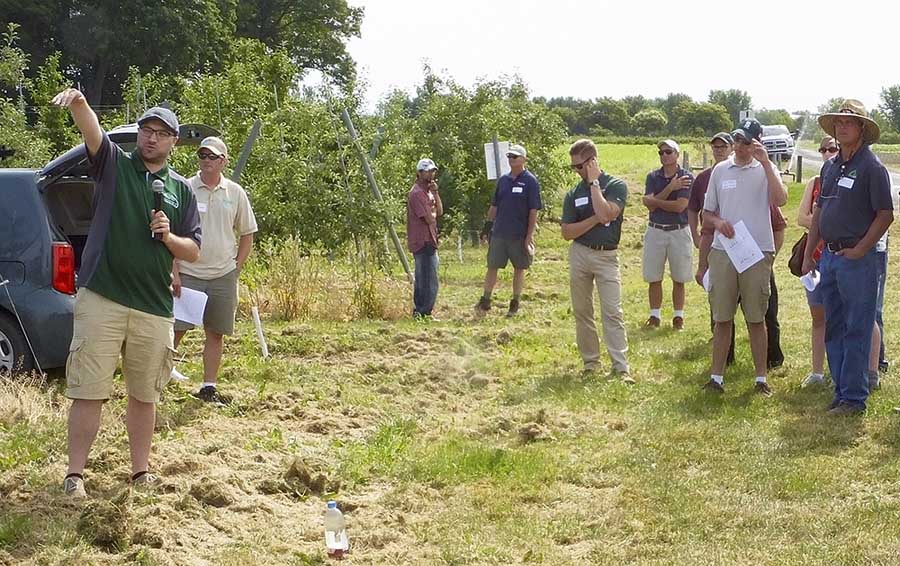
Chris Gottschalk, left, of the Michigan State University Department of Horticulture explains the importance of hard cider variety trials as part of a field day at the Clarksville Research Station in south central Lower Michigan. (by Leslie Mertz)
The growing consumer interest in hard ciders has turned many Great Lakes growers’ heads, but little is actually known about cider apple varieties, including which ones make good brews.
That’s a problem. And it’s why a research group at Michigan State University is embarking on a large project to sort out the characteristics of traditional cider apple varieties.
The MSU group had already begun studying varieties of red-juiced apples for potential cider use (read “Rosé cider anyone?”) when they started reviewing the research available on cider apples in the Great Lakes region.
“It was very, very limited. Almost no one was working on cider apples, not even the classic, heritage apples that had historical use for ciders,” said Chris Gottschalk, graduate research assistant in the research group of Steve van Nocker, professor in the MSU Department of Horticulture. “With the industry growing so rapidly, we just think there is a big need to get out there, do the variety trials, and supply growers and brewers with the information on these apples.”
With a new grant from the Michigan Horticultural Society, the researchers are establishing a collection of cider varieties at MSU’s Clarksville Research Station in south-central Lower Michigan.
Van Nocker’s group is collaborating on this project with Nikki Rothwell, coordinator of the Northwest Michigan Horticulture Research Center, who has previously conducted trials with a few varieties of cider apples, and with others, including Michigan State University tree fruit educator Phil Schwallier.

Steve van Nocker
Van Nocker and his research group planted 15 varieties of cider apple trees in 2016 and plan to expand to 150 varieties — 10 trees of each — over the next two years.
If funding allows, they plan to grow each variety on three high-density planting systems.
“The goal is to see how the trees behave under the high-density systems that will be most popular in 10 years, of course, assuming that at that point most of the crop will be harvested by machine,” van Nocker said.
He noted that juice and cider apples could be the first to be machine-harvested because they can sustain a bit of the damage that might accompany the early rollout of the technology.
During the project, the researchers plan to conduct genome-wide association studies across varieties to identify which genes are associated with certain traits, such as acid and sugar content, tannins and phenolic compounds.
Using that information, the group can make logical decisions about potentially breeding new varieties with superior cider specific traits.
“We’d also like to follow an enology approach similar to what they do with wine-variety trials,” Gottschalk said. “We would take the apples and ferment them in replicated series. This will give us an idea of what the resulting cider characteristics would be for each individual variety. Such knowledge would help brewers balance the attributes of the apples and produce assorted blends.”
This work is especially important in Michigan, which is the top U.S. producer of hard cider apples, Gottschalk said.
Currently, most producers make hard ciders out of surplus or second-rate culinary apples from packing houses, but these apples don’t have the tannins and body needed to make a really good cider.
“Our project is designed to give growers and brewers the information they need so they can make informed decisions about what to plant, how to grow the trees, whether an apple has potential as a single varietal, and how to blend juice,” he said.
He added, “Hopefully we can help out the specialty apple market, because we have a lot of hard cider producers in Michigan now, and almost every month I’m finding a new one coming up.
No one else is doing this work in apples, so we’re happy to take that on, especially with the growth we’re seeing within the industry.” •
– by Leslie Mertz






Thanks for this article. It is really great to see that data is being produced on the juice quality of cider apples across the nation. The more data we have, the better equipped we are to make decisions regarding which varieties to plant for making quality cider.
Reading the article, one thing that stands out is the use of the word “brewer” for someone who makes cider and the act of making cider as “brewing.”
I’d like to point out that there is no brewing involved with cider. It is simply “made” and the people who make it are “cidermakers” just as in the wine industry.
It might seem trivial, but part of the current challenge of cidermakers is to differentiate cider from beer, and ESPECIALLY low quality (cheaply made) flavored malt beverages masquerading as something like cider. The average consumer isn’t aware of the differences and the name brewer suggests that ingredients are mixed somehow, possibly even heated, to make a beverage called cider. Nothing of the sort goes on as cider is simply the fermented juice of apples just as wine is the fermented juice of grapes.
It is true that some cidermakers add other things to their cider, which is akin to what currently goes on in the “craft” beer world. I have enjoyed hopped ciders and ciders with grapefruit juice added so I don’t want to sound like I’m discouraging this practice. There is debate in the industry as to how much this can go on before it stops being cider. The purists will say, and I tend to agree, that anything added to apple juice renders it something other than cider. Wherever you draw the line, this still resembles winemaking more than it does brewing.
I applaud the work at MSU in helping to move the industry forward. I hope it’s clear that how cider is portrayed in the media is just as important as growing suitable apples for making it.
Many thanks,
Cidermakers Everywhere